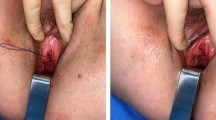Abstract
We characterized the tensile properties of five mid-urethral slings relative to the Gynecare TVT™. Slings were divided and loaded to failure. The heat-sealed Boston Scientific mid-section and the American Medical Systems (AMS) tensioning suture were examined separately. Analysis of the resulting nonlinear load elongation curves included calculation of low and high stiffness, the transition point between them (inflection point), load at failure, and relative elongation. Permanent elongation was measured after repetitive loads. Mean values were compared using a one-way analysis of variance. The curves of the Gynecare, Boston Scientific (no midsection) and AMS (no suture) were nonlinear with similar low stiffness and inflection points. The Bard, Caldera, and Mentor slings were stiffer. Heat sealing the Boston Scientific mid-section increased stiffness, while the AMS suture had negligible effect. Cyclical loading induced permanent elongation that was similar for Gynecare, AMS, and Boston Scientific (without mid-section) and lower for Bard, Caldera, and Mentor. With the exception of AMS, the overall effect of newer sling modifications was an increase in tensile stiffness.





Similar content being viewed by others
References
Ulmsten U, Henriksson L, Johnson P, Varhos G (1996) An ambulatory surgical procedure under local anesthesia for treatment of female urinary incontinence. Int Urogynecol J Pelvic Floor Dysfunct 7:81–85
Nilsson CG, Kuuva N, Falconer C, Rezapour M, Ulmsten U (2001) Long-term results of the tension-free vaginal tape (TVT) procedure for surgical treatment of female stress urinary incontinence. Int Urogynecol J Pelvic Floor Dysfunct 12(Suppl 2):S5–S8
Rezapour M, Ulmsten U (2001) Tension-free vaginal tape (TVT) in women with recurrent stress urinary incontinence—a long-term follow up. Int Urogynecol J Pelvic Floor Dysfunct 12(Suppl 2):S9–S11
Ward K, Hilton P (2002) Prospective multicenter randomised trial of tension-free vaginal tape and colposuspension as primary treatment for stress incontinence. BMJ 325:67–73
Ulmsten UI (2001) An introduction to tension-free vaginal tape (TVT)—a new surgical procedure for treatment of female urinary incontinence. Int Urogynecol J Pelvic Floor Dysfunct 12(Suppl 2):S3–S4
Wang KH, Wang KH, Neimark M, Davila GW (2002) Voiding dysfunction following TVT procedure. Int Urogynecol J Pelvic Floor Dysfunct 13:353–357
Dietz HP, Vancaillie P, Svehla M, Walsh W, Steensma AB, Vancaillie TG (2003) Mechanical properties of urogynecologic implant materials. Int Urogynecol J Pelvic Floor Dysfunct 14:239–243
Hammad FT, Kennedy-Smith A, Robinson RG (2005) Erosions and urinary retention following polypropylene synthetic sling: Australasian survey. Eur Urol 47:641–646
Siegel AL (2006) Urethral necrosis and proximal urethro-vaginal fistula resulting from tension-free vaginal tape. Int Urogynecol J Pelvic Floor Dysfunct 17:661–664
Karram MM, Segal JL, Vassallo BJ, Kleeman SD (2003) Complications and untoward effects of the tension-free vaginal tape procedure. Obstet Gynecol 101:929–932
Schumpelick V, Klinge U, Welty G, Klosterhalfen B (1999) Meshes within the abdominal wall. Chirurg 70:876–887
Acknowledgments
The authors would like to acknowledge the technical support provided by Kristen Debes BS and Katherine Clark, BS.
This study is supported by R01 HD NIH 045590, R01 AR NIH 39683 and RO1 AR NIH 41820.
Conflicts of interest
None.
Author information
Authors and Affiliations
Corresponding author
Rights and permissions
About this article
Cite this article
Moalli, P.A., Papas, N., Menefee, S. et al. Tensile properties of five commonly used mid-urethral slings relative to the TVT™. Int Urogynecol J 19, 655–663 (2008). https://doi.org/10.1007/s00192-007-0499-1
Received:
Accepted:
Published:
Issue Date:
DOI: https://doi.org/10.1007/s00192-007-0499-1




